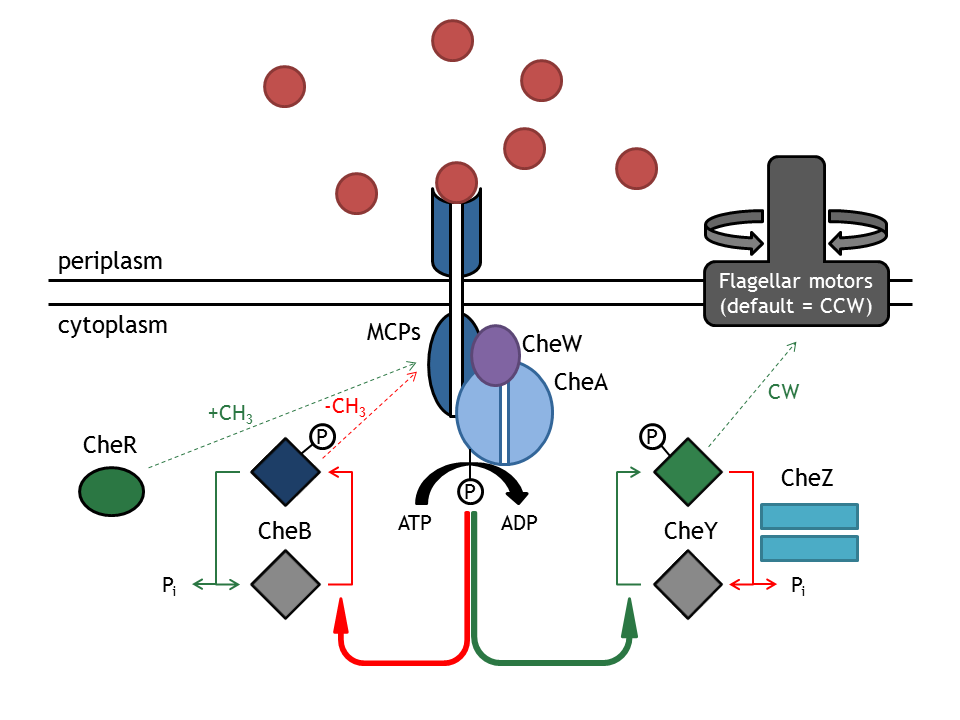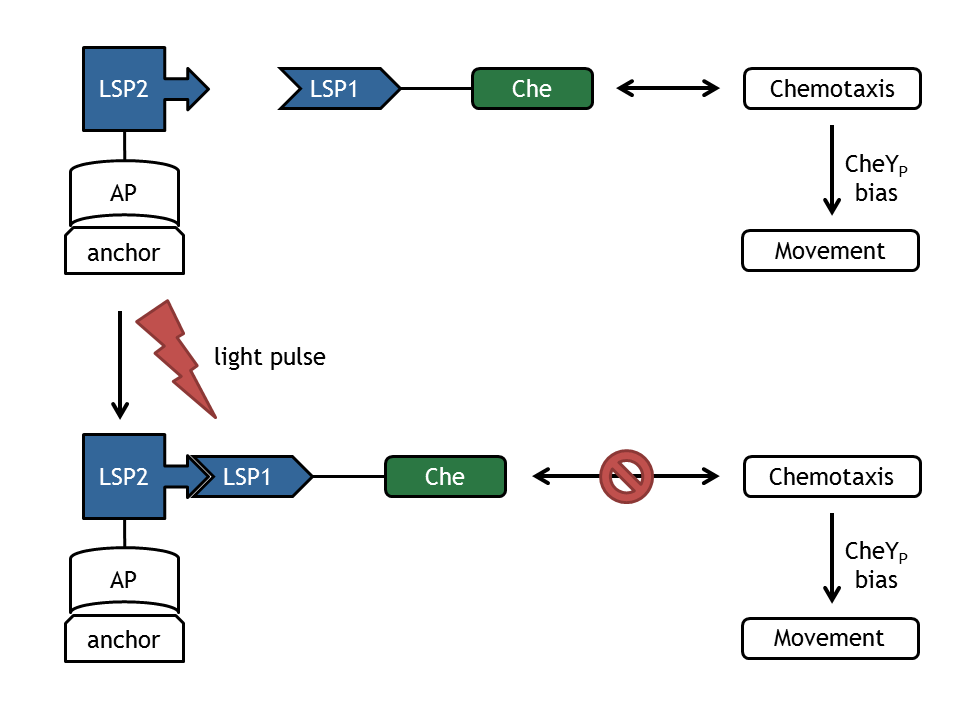Team:ETHZ Basel/Biology/Molecular Mechanism
From 2010.igem.org
| Line 1: | Line 1: | ||
{{ETHZ_Basel10}} | {{ETHZ_Basel10}} | ||
| - | {{ | + | {{ETHZ_Basel10_Project}} |
= Molecular mechanism = | = Molecular mechanism = | ||
Revision as of 10:14, 18 October 2010
Molecular mechanism
Network topology
The chemotactic network is responsible for the directed movement of the bacterium, as a response to changes in the extracellular chemoattractant or chemorepellent concentration. The two types of movement that the bacterium can employ are tumbling (i.e. change in angle and no change in position), occurring when the bacterium doesn’t sense an increase in attractant concentration and running straight ( i.e. change in position and no change in angle), occurring when the attractant concentration is sensed as increasing.
This network consists of membrane receptor proteins (MCPs) and intracellular proteins (Che). MCPs sense the change in input concentration and communicate the information to the proteins CheW and CheA, located inside the cell. The autophosphorylation of CheA mediated by the MCPs is the key step in tumbling induction in response to increased repellent or decreased attractant concentration. The methylation state of the MCPs is influenced by the methyltransferase CheR and the demethylase CheB which counteracts the effect of CheR by demethylation of the receptor complex. CheA phosphorylates CheY which then diffuses through the cytoplasm to the flagellar motor protein FliM where it induces tumbling. The phosphatase CheZ regulates the signal termination through dephosphorylation of CheYp [8].
The movement simulation algorithm (stochastic movement model) takes into consideration the change in the angle, as you can see here Movement. A running state is defined by BOTH a change in the movement angle AND a change in the spatial coordinates. As the E.coli runs along an axis, its coordinates obviously change. In contrast to this, during the tumbling state, only the movement angle changes. As the bacterium remains at its place, no change in the spatial coordinates is predicted. It is suggested by the model that the stochastic distribution of the two states are CheYp dependent. For example at CheYp = 12.5 nM, both states are equally probable, but when CheYp is increased to 25 nM, tumbling is dominant. Our models are strongly supported by other simulation studies, which predict that the phosphorylation level of CheY interacts with the flagellum apparatus and therefore also influences the stochastic distribution of the two states. In E. coli, these two types of movements correspond to different rotation directions of its 4 flagellar motors (clockwise: tumbling; counter-clockwise: running).
Light activated system: PhyB-Pif3
In plants and some bacteria, members of the photoreceptor family of phytochromes regulate phototaxis, photosynthesis and production of protective pigments in response to light stimuli. The chromophore is encoded in the N-terminal domain of the protein [1]. There are two mayor types of phytochromes, type I (PhyA) and type II (PhyB and PhyC) [2, p.142]. Both exist in a biologically inactive form Pr absorbing red light and an active configuration Pfr which absorbs far-red light using a covalently attached tetraphyrrole chromophore for light absorption [5]. The interconversion between these two states takes only miliseconds [3]. While the Pr form is very stable (half live of about 100h), the Pfr form is faster degraded (type I half-life between 30min and 2h, type II half live around 8h) [2, p.142 ff].
Light-switchable gene systems utilize the phytochrome interacting factor Pif3, a basic helix-loop-helix protein, for light-induced gene expression. The N-Terminus of Pif3 selectively binds the Prf form of the phytochrome and rapidely dissociates in response to reconversion to the Pr state [3].
For the design of a light-activated system in Bacteria one has to consider that chromophores such as phycocyanobilin PBS are not naturally present; therefore, they either have to be added to the media or two genes for its biosynthesis starting from Haem have to be introduced [4]. Furthermore, the fact that phyotochromes can form sequesters in the Prf state in the timescale of seconds has to be examined [2].
Molecular Mechanism of the E. lemming
Remover part cos in overview?
The core element of E. lemming is spatial localization of certain elements of the chemotactic network (Che proteins) and thus affecting the activity of their downstream partners. This anchoring is achieved with the help of light-sensitive proteins LSP's that dimerize upon a light signal. Dimerization results in spatial relocalization of the Che-protein and therefore altering the ratio between tumbling and directed flagellar movement.
Inside the cell, the chemotactic proteins CheA, CheY and CheZ tend to co-localize with methyl accepting chemotaxis protein MCPs at the membrane. But whereas CheA and CheZ nearly only localize at the MCPs, CheY is also present in significant concentrations in the cytoplasm making it's localization more straightforward [1].
For spatial localization of the Che-protein complex, three different anchor-proteins will be utilized:
1. The tetracyclin repressor tetR anchoring the Che-protein to the DNA by binding to it's operator site tetO that has been inserted into a plasmid [2].
2. The triggor factor TrigA binding to the large ribosomal subunit [3].
3. The prokaryotic actin homologue MreB which assembles into helical filaments underneath the cytoplasmic membrane [4].
These anchors should enable to control the tumbling frequency by localizing a Che-protein and therefore interfering with its activity.
References
[1] Sato, Hug, Tepperman and Quail: A light-switchable gene promoter system. Nature Biotechnology. 2002; 20.
[2] Kendrick and Kronenberg: Photomorphogenesis in plants. Kluwer academic publishers, Dordrecht, The Netherlands. 2nd edition, 1994.
[3] Keyes and Mills: Inducible systems see light. Trends in Biotechnology. 2003; 21:2.
[4] Levskaya, Chevalier, Tabor, Simpson, Lavery, Levy, Davidson, Scourast, Ellington, Marcotte and Voigt: Engineering Escherichia coli to see light. Nature Brief Communications. 2005, 438.
Reference for which part? [5] Amy B Tyszkiewicz and Tom W Muir: Activation of protein splicing with light in yeast. Nature Methods Brief Communications. 2008, 5:303-305
Reference for which part? [6] Yuri Matsuzakia, Shinichi Kikuchia and Masaru Tomita: Robust effects of Tsr–CheBp and CheA–CheYp affinity in bacterial chemotaxis. Artificial Intelligence in Medicine. 2007; 41:2
Reference for which part? [7] Matthew D. Levin, Carl J. Morton-Firth, Walid N. Abouhamad, Robert B. Bourretand Dennis Bray: Origins of Individual Swimming Behavior in Bacteria. Biophysical Journal. 1998; 74:1
[8] M.J. Tindall, S.L. Porter, P.K. Maini, G. Gaglia, J.P. Armitage. Bulletin of Mathematical Biology (2008) 70: 1525–1569
 "
"





